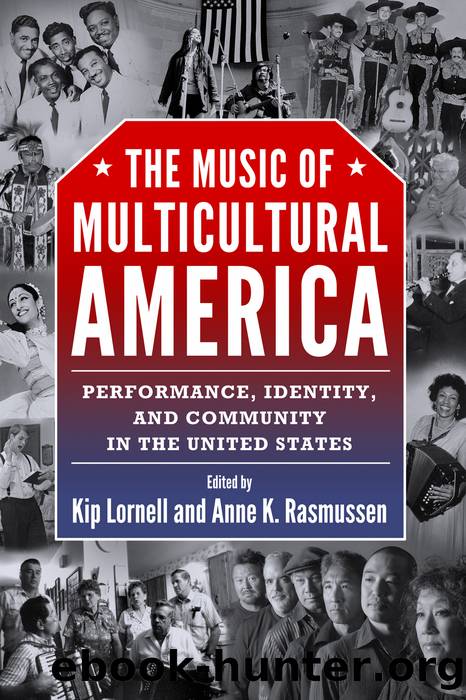The Music of Multicultural America by Unknown

Author:Unknown
Language: eng
Format: epub
Publisher: University Press of Mississippi
Published: 2016-08-15T00:00:00+00:00
MATACHINA AS A RECEIVED OR BORROWED TRADITION
The Spanish matachines is one of the most recently received music/dance forms in the Pueblos, who call it Matachina, the term used in this chapter when referring specifically to Pueblo versions. The Puebloans have a long-standing tradition of borrowing or receiving songs and ceremonies (Ellis 1964, 57; Humphreys 1984, 29â56; Ortiz 1972, 147; Romero 1993, 148, 154). Whether from other native tribes or from the Spanish, âborrowed traits were usually adapted to existent patterns and tended to add rather than substitute religious traitsâ (Ellis 1964, 57). This practice of adaptation (a process of syncretism) is crucial for understanding traditional American Indian worldview, which underscores respect for the power inherent in song, dance, and ceremony per se. Recognizing only one Creation composed of a myriad of peoples and languages, American Indians in general perceive no conflict between different tribal belief systems. The people were eager in the past to acquire a song or ceremony known to be powerful in hunting, healing, or other ritualized activities. For instance, the Pueblos also have a buffalo dance, received from Plains groups, for whom religious ideology revolves around the buffalo. Reciprocal sharing or payment of some kind would normally accompany the adoption of a new ceremony from the outside.
No doubt in the past some ceremonies were âreceivedâ along with entire bands of extended families subdued in battle or otherwise adopted. In that case a leader of that group could become the head of the particular Pueblo society responsible for the new ceremony, a strategic cooptive practice. The Pueblo kivas take great care to perform and observe all of a ceremonyâs attending requirements.
It is not known when the Spanish first introduced the Matachina pantomime (that is, without song texts or lyrics), and it remains the only pantomime of its kind performed in the Pueblos.
But, while the Spanish may have believed that they were replacing traditional beliefs by allowing matachines as the only masked dance, the Puebloans more likely believed that they were being given the source of spiritual power that the matachines ceremony gave to the Spanish. Today, the Pueblo of Jemez Turquoise Kiva Matachina is also an example of how a music/dance ceremony received from a highly divergent foreign source may be reinterpreted, or tailored, to fit existent ceremonial Pueblo formats. In spite of the Puebloans having learned Spanish polyphony in the early colonial period, the Matachina is the only ceremony of the Pueblos that uses European music and instruments. The Pueblo of Jemez Pumpkin Kiva Matachina version has reinterpreted the tradition to the extent that it no longer resembles the âSpanishâ version that uses the violin and guitar; instead, it uses male chorus and drum accompaniment. Nonetheless, the Iberian-rooted choreography is very similar in these two versions, requiring stamina and an agile solo dancer, in addition to more typical group dancing. Like the corn dance, the Matachina dance in some Pueblos involves an animated crowd and a highly charged atmosphere. Friends and relatives visit at this time, and
Download
This site does not store any files on its server. We only index and link to content provided by other sites. Please contact the content providers to delete copyright contents if any and email us, we'll remove relevant links or contents immediately.
The Goal (Off-Campus #4) by Elle Kennedy(13452)
Kathy Andrews Collection by Kathy Andrews(11705)
Diary of a Player by Brad Paisley(7455)
What Does This Button Do? by Bruce Dickinson(6120)
Assassin’s Fate by Robin Hobb(6099)
Big Little Lies by Liane Moriarty(5677)
Altered Sensations by David Pantalony(5027)
Pale Blue Dot by Carl Sagan(4883)
Sticky Fingers by Joe Hagan(4083)
The Death of the Heart by Elizabeth Bowen(3529)
The Heroin Diaries by Nikki Sixx(3475)
Beneath These Shadows by Meghan March(3248)
Confessions of a Video Vixen by Karrine Steffans(3228)
How Music Works by David Byrne(3151)
The Help by Kathryn Stockett(3066)
Jam by Jam (epub)(3003)
Harry Potter 4 - Harry Potter and The Goblet of Fire by J.K.Rowling(2967)
Strange Fascination: David Bowie: The Definitive Story by David Buckley(2780)
Petty: The Biography by Warren Zanes(2680)
